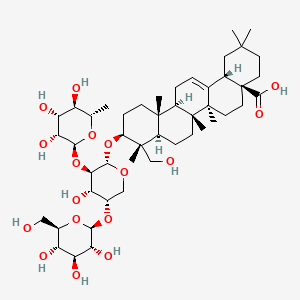Pulsatilla saponin D, SB365 compound



| Name | Pulsatilla saponin D | ||
| PubChem CID | 11650910 | ||
| Molecular Weight | 913.1g/mol | ||
| Synonyms |
Pulsatilla saponin D, SB365 compound |
||
| Formula | C₄₇H₇₆O₁₇ | ||
| SMILES | CC1C(C(C(C(O1)OC2C(C(COC2OC3CCC4(C(C3(C)CO)CCC5(C4CC=C6C5(CCC7(C6CC(CC7)(C)C)C(=O)O)C)C)C)OC8C(C(C(C(O8)CO)O)O)O)O)O)O)O | ||
| InChI | 1S/C47H76O17/c1-22-30(50)33(53)35(55)38(60-22)64-37-32(52)26(62-39-36(56)34(54)31(51)25(19-48)61-39)20-59-40(37)63-29-11-12-43(4)27(44(29,5)21-49)10-13-46(7)28(43)9-8-23-24-18-42(2,3)14-16-47(24,41(57)58)17-15-45(23,46)6/h8,22,24-40,48-56H,9-21H2,1-7H3,(H,57,58)/t22-,24-,25+,26-,27+,28+,29-,30-,31+,32-,33+,34-,35+,36+,37+,38-,39-,40-,43-,44-,45+,46+,47-/m0/s1 | ||
| InChIKey | SOLICHUQXFAOEP-YDIXZRNLSA-N | ||
| CAS Number | 68027-15-6 | ||
| ChEMBL ID | CHEMBL479310 | ||
| ChEBI ID | CHEBI:66790 | ||
| Structure | 
|
Download
2D
MOL
3D
MOL
|
|
| Chineses Pinyin | BaiTouWeng | ||
| Use Part | Root | ||
| Habitat | HeiLongJiang, JiLin, LiaoNing, NeiMengGu, HeBei | ||
| Flavor | Bitter | ||
| Meridian Tropism | Stomach, Large intestine | ||
| Species |
>Kingdom: Viridiplantae
-->Phylum: Streptophyta
-->Class: Equisetopsida
-->Order: Ranunculales
-->Family: Ranunculaceae
-->Genus: Pulsatilla
-->Species: Pulsatilla chinensis
|
||
| Pair Name | Pulsatilla saponin D, Temozolomide | |||
| Partner Name | Temozolomide | |||
| Disease Info | [ICD-11: 2A00] | Glioblastoma multiforme | Investigative | |
| Biological Phenomena | Induction-->Triggering caspase-independent cell death | |||
| Gene Regulation | Up-regulation | Cleavage | CASP3 | hsa836 |
| Up-regulation | Expression | MAP1LC3B | hsa81631 | |
| Up-regulation | Expression | SQSTM1 | hsa8878 | |
| Up-regulation | Expression | ROS1 | hsa6098 | |
| Up-regulation | Expression | CTSB | hsa1508 | |
| In Vitro Model | T98G | Glioblastoma | Homo sapiens (Human) | CVCL_0556 |
| U-87MG ATCC | Glioblastoma | Homo sapiens (Human) | CVCL_0022 | |
| Result | SB365 inhibits autophagic flux and induces caspase-independent cell death in GBM cells in a manner involving cathepsin B and mainly reactive oxygen species, and its use in combination with temozolomide shows promise for the treatment of GBM. | |||
| Pair Name | Pulsatilla saponin D, Paclitaxel | |||
| Partner Name | Paclitaxel | |||
| Disease Info | [ICD-11: 2C25.Z] | Lung cancer | Investigative | |
| Gene Regulation | Down-regulation | Expression | RAC3 | hsa5881 |
| In Vitro Model | NCI-H1299 | Lung large cell carcinoma | Homo sapiens (Human) | CVCL_0060 |
| A-549 | Lung adenocarcinoma | Homo sapiens (Human) | CVCL_0023 | |
| In Vivo Model | A total of 5×10⁶ A549-PR and NCI-H1299-PR cells were subcutaneously injected near the dorsal flanks of the mice. | |||
| Result | We found that treatment with paclitaxel combined with Pulsatilla saponin D, can overcome lung adenocarcinoma cell resistance to paclitaxel alone in cell culture and mouse xenograft models. | |||
| No. | Title | Href |
|---|---|---|
| 1 | SB365, Pulsatilla Saponin D Induces Caspase-Independent Cell Death and Augments the Anticancer Effect of Temozolomide in Glioblastoma Multiforme Cells. Molecules. 2019 Sep 5;24(18):3230. doi: 10.3390/molecules24183230. | Click |
| 2 | Pulsatilla saponin D regulates ras-related C3 botulinum toxin substrate 3 (RAC3) to overcome resistance to paclitaxel in lung adenocarcinoma cells. BMC Cancer. 2024 Jan 10;24(1):55. doi: 10.1186/s12885-024-11841-6. | Click |
